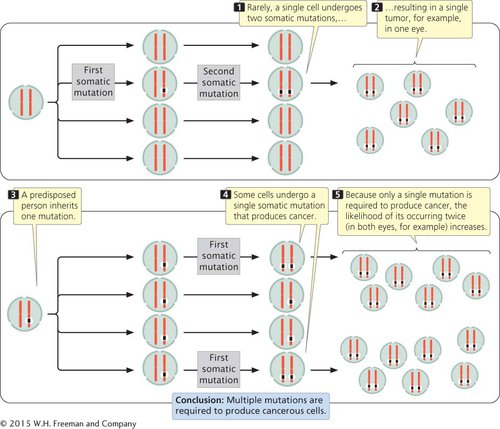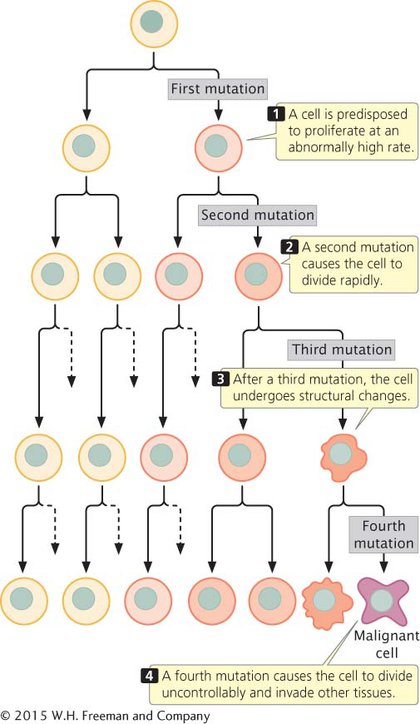Cancer as a Genetic Disease
Cancer arises as a result of fundamental defects in the regulation of cell division, and its study therefore has significance not only for public health, but also for our basic understanding of cell biology. Through the years, many ideas have been put forth to explain cancer, but we now recognize that most, if not all, cancers arise from defects in DNA.
EVIDENCE FOR THE GENETIC THEORY OF CANCER Early observations suggested that cancer might result from genetic damage. First, many agents that cause mutations, such as ionizing radiation and chemicals, also cause cancer (are carcinogens; see Chapter 13). Second, some cancers are consistently associated with particular chromosome abnormalities. About 90% of people with chronic myeloid leukemia, for example, have a reciprocal translocation between chromosome 22 and chromosome 9. Third, some specific types of cancers tend to run in families. Retinoblastoma, a rare childhood cancer of the retina, appears with high frequency in a few families, in which it is inherited as an autosomal dominant trait, suggesting that a single gene is responsible for these cases of the disease.
Although these observations hinted that genes play some role in cancer, the theory of cancer as a genetic disease had several significant problems. If cancer is inherited, every cell in the body should receive the cancer-
KNUDSON’S MULTISTEP MODEL OF CANCER In 1971, Alfred Knudson proposed a model to explain the genetic basis of cancer. Knudson was studying retinoblastoma, which usually develops in only one eye but occasionally appears in both. Knudson found that when retinoblastoma appears in both eyes, it presents itself at an early age, and that many children with bilateral retinoblastoma have close relatives who are also affected.
Knudson proposed that retinoblastoma results from two separate genetic defects, both of which are necessary for cancer to develop (Figure 16.3). He suggested that in the cases in which the disease affects just one eye, a single cell in one eye undergoes two successive mutations. Because the chance of these two mutations occurring in a single cell is remote, retinoblastoma is rare and typically develops in only one eye. Knudson proposed that children with bilateral retinoblastoma have inherited one of the two mutations required for the cancer, and so every cell contains this initial mutation. In these cases, all that is required for cancer to develop is for one eye cell to undergo the second mutation. Because each eye possesses millions of cells, the probability that the second mutation will occur in at least one cell of each eye is high, so tumors may occur in both eyes at an early age.

Knudson’s proposal suggests that cancer is the result of a multistep process that requires several mutations. If one or more of the required mutations are inherited, fewer additional mutations are required to produce cancer, and the cancer will tend to run in families. Knudson’s idea has been called the “two-
430
Knudson’s genetic theory of cancer has been confirmed by the identification of genes that, when mutated, cause cancer. Today, we recognize that cancer is fundamentally a genetic disease, although few cancers are actually inherited. Most tumors arise from somatic mutations that accumulate over a person’s life span, either through spontaneous mutation or in response to environmental mutagens.  TRY PROBLEM 18
TRY PROBLEM 18
THE CLONAL EVOLUTION OF TUMORS Cancer begins when a single cell undergoes a mutation that causes the cell to divide at an abnormally rapid rate. The cell proliferates, giving rise to a clone of cells, each of which carries the same mutation. Because the cells of the clone divide more rapidly than normal, they soon outgrow other cells. An additional mutation that arises in some of the clone’s cells may further enhance the ability of those cells to proliferate, and cells carrying both mutations soon become the most common cells in the clone. Eventually, they may be overtaken by cells that contain yet more mutations that enhance proliferation. In this process, called clonal evolution, the tumor cells acquire more mutations that allow them to become increasingly more aggressive in their proliferative properties (Figure 16.4).

The rate of clonal evolution depends on the frequency with which new mutations arise. Any genetic defect that allows more mutations to arise will accelerate cancer progression. Genes that regulate DNA repair are often found to have been mutated in the cells of advanced cancers, and inherited disorders of DNA repair are usually characterized by increased incidences of cancer. Because DNA-
431
Mutations in genes that affect chromosome segregation may also contribute to the clonal evolution of tumors. Many cancer cells are aneuploid (contain extra or missing copies of individual chromosomes; see Chapter 6), and clearly, chromosome mutations contribute to cancer progression by duplicating some genes (those on extra chromosomes) and eliminating others (those on deleted chromosomes). Cellular defects that interfere with chromosome separation increase aneuploidy and may therefore accelerate cancer progression.
CONCEPTS
Cancer is fundamentally a genetic disease. Mutations in several genes are usually required to produce cancer. If one of those mutations is inherited, fewer somatic mutations are necessary for cancer to develop, and the person may have a predisposition to cancer. Clonal evolution is the accumulation of mutations in a clone of cells.
 CONCEPT CHECK 1
CONCEPT CHECK 1
How does the multistep model of cancer explain the observation that sporadic cases of retinoblastoma usually appear in only one eye, whereas inherited forms of the cancer appear in both eyes?
Retinoblastoma results from at least two separate genetic defects, both of which are necessary for cancer to develop. In sporadic cases, two successive mutations must occur in a single cell, which is unlikely, and therefore the cancer typically occurs in only one eye. In people who have inherited one of the two required mutations, every cell contains this mutation, meaning only a single additional mutation is required for cancer to develop. Given the millions of cells in each eye, there is a high probability that the second mutation will occur in at least one cell of each eye, producing tumors in both eyes and the inheritance of this type of retinoblastoma.